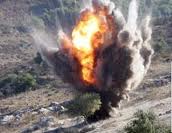
UN teams halt cluster-bomb clearance as funds dry up ~ De-miners expect surge in civilian casualties

Source: AFP, 31-8-2008
Rima Abushakra
TYRE: Mohammad Balhas was on his tractor clearing a patch of land near his home in Southern Lebanon last week when a cluster bomb exploded, shooting shrapnel into his chest and left leg. "I didn't know what hit me. Suddenly blood was pouring from my chest," said the 36-year-old Balhas. With funds drying up for the massive de-mining operations under way in Southern Lebanon since the end of the summer 2006 war with "Israel", the UN fears that such incidents, already all too frequent, will increase.
The de-mining teams have been working all-out to clear the more than 1 million cluster bombs "Israel" dropped throughout South Lebanon during the last days of its devastating 34-day war on the country in July-August 2006.
However, many of the 44 teams doing the work have had to lay down their metal detectors at the end of August due to lack of funds, according to Dalya Farran, spokeswoman for the UN Mine Action Coordination Center (MACC).
"Our productivity in clearing contaminated areas will be cut by 50 percent at the end of the month when the teams stop their work," Farran said, adding that the 2008 budget was short $4.7 million.
"And 2009 is a whole other story. Without funding, we will have to stop all the teams," Farran said.
The teams working alongside the Lebanese Army and UN forces comprise around 1,000 people, most of them Lebanese.
The work is dangerous - in the two years since the war's end, 27 civilians and 13 de-miners have been killed and 234 civilians and 39 de-miners wounded as a result of cluster bombs and unexploded ordnance, according to MACC.
Farran said 1,058 sites contaminated by cluster bombs and unexploded ordnance from the 2006 war had been identified. The combined area of the sites totals around 41 square kilometers, she added.
Clearance teams, dressed in protective clothing and headgear, pass their metal detectors over every centimeter of the contaminated sites and mark the area where there is a metallic presence.
Other experts then come to dig up any bombs and transport them to another site where they are exploded.
As Mohammad Balhas recovers at his home from the two operations he has endured to remove the shrapnel from his chest, he contemplates going back to work.
But the thought is daunting.
"Of course we are afraid to work and do our jobs, but we have to. We have to put food on the table," he said.
As the de-mining teams cease their operations, "the potential for accidents will definitely increase" according to Farran who said that 2005 saw a "dramatic increase" in the casualty rate when a previous de-mining operation was stopped.
According to Farran, "43 percent of the areas affected by the cluster bombs dropped during the July 2006 war have been cleared and the direct threat has been eliminated from 49 percent of the contaminated areas - which means the surface bombs have been removed ... Eight percent still needs to be worked on."
But it's not only the lethal bomblets that are causing sleepless nights for residents.
"Aside from the cluster bombs, we still have 300,000 land mines along the Blue Line [the UN-demarcated frontier with "Israel"]," said Tyre Mayor Abdel Hosn al-Husseini, referring to mines laid by "Israel" before its withdrawal from most of South Lebanon in 2000.
"Maybe Georgia is distracting donors' attention," he said.
Husseini said that 45,000 cluster bombs were cleared from one village alone.
"Many of the bombs were dropped on agricultural lands, which means farmers are staying away from their land," he said.
He estimated that 80 percent of the people in Southern Lebanon worked in the agricultural sector, particularly tobacco, olives and bananas.
When an area is cleared, the surface bombs are removed as well as those detected below the surface. But there is always risk that some go undetected.
"We will continue to feel the effects of cluster bombs for another 100 or 200 years," said Yehya Balhas, a 43-year-old farmer. "This area was supposed to be clean, but our neighbor was hurt just the other day when one blew up. There are some areas where you can't even work the land."
His 4-year-old niece Mariam recognizes cluster bombs from television ads.
"I saw one with a white string on it in the field and ran away. I also saw one on the road when we first came back," she said referring to her family's return after fleeing the bombardment during the war.
While the funding issue presents a major hindrance to the bomb-clearing effort, Farran maintains that the main impediment is the fact that "Israel" has not revealed any information on the cluster bombs that its air forces dropped.
"The United Nations has repeatedly requested cluster bomb data from "Israel" [including maps and the type of ordnance dropped], but in two years plus, we still haven't received the requested data," Farran said. "This remains the main obstacle to the cluster bomb clearing effort."
News of the scaling back of the de-mining effort has not been reassuring for locals.
Tohmeh Tohmeh, 50, a well-wisher visiting Mohammad Balhas after his accident, himself was a casualty of a land mine blast in 1996.
"I was hurt from head to toe. My stomach was literally blown open and I lost sight in my right eye," he says.
"Now they are stopping the de-mining, but we are still dying," he added.
Rima Abushakra
TYRE: Mohammad Balhas was on his tractor clearing a patch of land near his home in Southern Lebanon last week when a cluster bomb exploded, shooting shrapnel into his chest and left leg. "I didn't know what hit me. Suddenly blood was pouring from my chest," said the 36-year-old Balhas. With funds drying up for the massive de-mining operations under way in Southern Lebanon since the end of the summer 2006 war with "Israel", the UN fears that such incidents, already all too frequent, will increase.
The de-mining teams have been working all-out to clear the more than 1 million cluster bombs "Israel" dropped throughout South Lebanon during the last days of its devastating 34-day war on the country in July-August 2006.
However, many of the 44 teams doing the work have had to lay down their metal detectors at the end of August due to lack of funds, according to Dalya Farran, spokeswoman for the UN Mine Action Coordination Center (MACC).
"Our productivity in clearing contaminated areas will be cut by 50 percent at the end of the month when the teams stop their work," Farran said, adding that the 2008 budget was short $4.7 million.
"And 2009 is a whole other story. Without funding, we will have to stop all the teams," Farran said.
The teams working alongside the Lebanese Army and UN forces comprise around 1,000 people, most of them Lebanese.
The work is dangerous - in the two years since the war's end, 27 civilians and 13 de-miners have been killed and 234 civilians and 39 de-miners wounded as a result of cluster bombs and unexploded ordnance, according to MACC.
Farran said 1,058 sites contaminated by cluster bombs and unexploded ordnance from the 2006 war had been identified. The combined area of the sites totals around 41 square kilometers, she added.
Clearance teams, dressed in protective clothing and headgear, pass their metal detectors over every centimeter of the contaminated sites and mark the area where there is a metallic presence.
Other experts then come to dig up any bombs and transport them to another site where they are exploded.
As Mohammad Balhas recovers at his home from the two operations he has endured to remove the shrapnel from his chest, he contemplates going back to work.
But the thought is daunting.
"Of course we are afraid to work and do our jobs, but we have to. We have to put food on the table," he said.
As the de-mining teams cease their operations, "the potential for accidents will definitely increase" according to Farran who said that 2005 saw a "dramatic increase" in the casualty rate when a previous de-mining operation was stopped.
According to Farran, "43 percent of the areas affected by the cluster bombs dropped during the July 2006 war have been cleared and the direct threat has been eliminated from 49 percent of the contaminated areas - which means the surface bombs have been removed ... Eight percent still needs to be worked on."
But it's not only the lethal bomblets that are causing sleepless nights for residents.
"Aside from the cluster bombs, we still have 300,000 land mines along the Blue Line [the UN-demarcated frontier with "Israel"]," said Tyre Mayor Abdel Hosn al-Husseini, referring to mines laid by "Israel" before its withdrawal from most of South Lebanon in 2000.
"Maybe Georgia is distracting donors' attention," he said.
Husseini said that 45,000 cluster bombs were cleared from one village alone.
"Many of the bombs were dropped on agricultural lands, which means farmers are staying away from their land," he said.
He estimated that 80 percent of the people in Southern Lebanon worked in the agricultural sector, particularly tobacco, olives and bananas.
When an area is cleared, the surface bombs are removed as well as those detected below the surface. But there is always risk that some go undetected.
"We will continue to feel the effects of cluster bombs for another 100 or 200 years," said Yehya Balhas, a 43-year-old farmer. "This area was supposed to be clean, but our neighbor was hurt just the other day when one blew up. There are some areas where you can't even work the land."
His 4-year-old niece Mariam recognizes cluster bombs from television ads.
"I saw one with a white string on it in the field and ran away. I also saw one on the road when we first came back," she said referring to her family's return after fleeing the bombardment during the war.
While the funding issue presents a major hindrance to the bomb-clearing effort, Farran maintains that the main impediment is the fact that "Israel" has not revealed any information on the cluster bombs that its air forces dropped.
"The United Nations has repeatedly requested cluster bomb data from "Israel" [including maps and the type of ordnance dropped], but in two years plus, we still haven't received the requested data," Farran said. "This remains the main obstacle to the cluster bomb clearing effort."
News of the scaling back of the de-mining effort has not been reassuring for locals.
Tohmeh Tohmeh, 50, a well-wisher visiting Mohammad Balhas after his accident, himself was a casualty of a land mine blast in 1996.
"I was hurt from head to toe. My stomach was literally blown open and I lost sight in my right eye," he says.
"Now they are stopping the de-mining, but we are still dying," he added.


